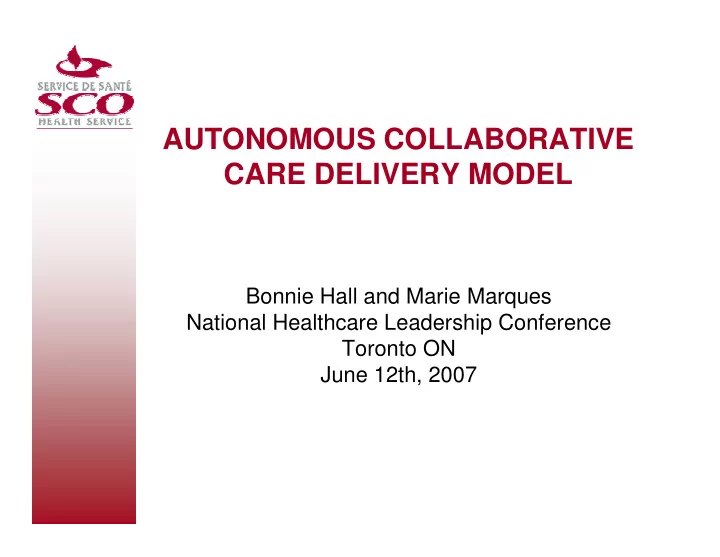

AUTONOMOUS COLLABORATIVE CARE DELIVERY MODEL Bonnie Hall and Marie Marques National Healthcare Leadership Conference Toronto ON June 12th, 2007
Overview of Presentation • Provide an overview of an innovative care delivery model • Discuss the implementation • Evaluation • Lessons learned
Vision for Patient Care & System Effectiveness SCO Health Patient- Service Centered Philosophy of Care patient care Nursing Nursing Professional Governance Practice Model Nursing Advisory Committee Autonomous Nursing Care Delivery Model Collaborative Care Delivery Model
Care Delivery Model Autonomous-Collaborative Care Model Registered Registered Practical Nurse Nurse Interdisciplinary Team Patients and Families Personal Care Attendant
Definitions of Terms • Autonomous – Freedom to act on what you know, to make independent clinical decisions that exceed standard nursing practice, in the best interest of the patient. • Collaboration – Collaborative Nursing Practice means sharing in planning, decision-making, problem solving and goal setting.
General Principles Guiding the Autonomous – Collaborative Care Model • Provides for the highest level of continuity of care • Provides for smallest number of different categories of workers assigned to a patient on any given shift • Ensures highest level of autonomy for the care provider • Ensures the right category of care provider
Guiding Principles • Knowledge • Caring – Continuity of Care – Therapeutic Relationship • Collaboration • Patient-Centered Care • Healthy Work Environment Role Expectations- RN, RPN, PCA
Implementation Communication plan: – Nursing Advisory Committee – Medical Advisory Committee – Professional Advisory Committee – Management Team – Unit specific sessions – all shifts • Collaboration: – Nursing Resource Team and Managers – Evaluation
Evaluation Evaluation direct observation and focus groups • RNs – assigned to most complex patients – assigned to all new admissions until a plan of care is in place • RPNs – family conferences and team rounds – contacting the physician when patients’ conditions change – working autonomously when caring for stable and predictable patients – performing an increased number of nursing skills based on knowledge, skills and judgment and policies revised to enable full scope of practice • PCAs – no longer assigned responsibility for overall care of patient but rather, to aspect of personal and basis care
Evaluation: Number of Care Providers # Different Care Providers Total (x/21) Pre Post Post T1(6 months) T2 (18 months) 13.6 10.9 10.9 •Audit (random sample 10%-week) number of times a different care provider was assigned • Lower the score, that is, the least number of different care providers, the better the outcome • � 3 individual (21.4%)
Right Category of Care Provider Unit #Times Right # Times Right # Times Right # Times Right Care Provider Care Provider Care Provider Care Provider Assigned Assigned Assigned Assigned Days (x/7) Eve (x/7) Night (x/7) Total (x/21) Pre Pos Pos Pre Pos Pos Pre Pos Pos Pre Pos Pos t t t t t t t t T1 T2 T1 T2 T1 T2 T1 T2 CCCP 3.6 5.8 6.2 6.2 5.25 5.8 4.4 6.8 5.7 12. 17.4 18.0 1 � Right category of care provider assigned to appropriate type of patient � Complexity, stability and predictability � Audit patient care assignment patterns � 57.6% to 85.7 % (48.7% improvement)
Lessons Learned • Leadership • Courage • Collaboration • Supporting staff through all the phases of the change process • Communication • Valuing staff through the journey
The decisions that you make and the actions that you take upon the Earth are the means by which you evolve.
Thank You
Coordinates of Speakers Bonnie Hall RN MScN, GNC(C) Advance Practice Nurse bhall@scohs.on.ca Marie Marques, RN, BA, MPA(c) CRRN Clinical Manager mmarques@scohs.on.ca
Recommend
More recommend